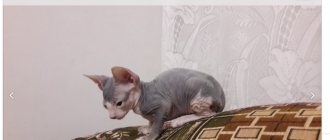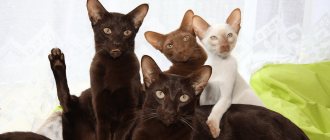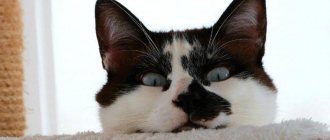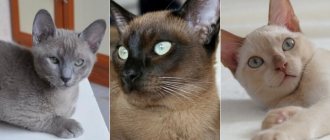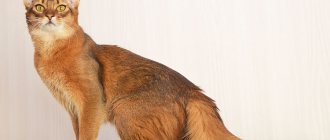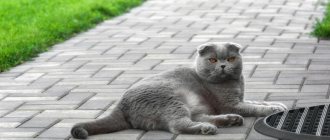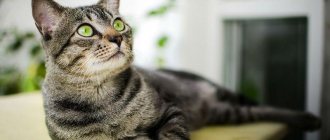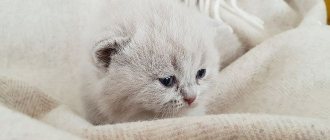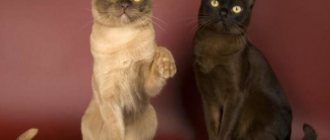Cats are beloved pets all over the world. Someone brings kittens from the street and cares for them. Someone buys interesting breeds and participates in exhibitions. Someone breeds many cats and devotes their entire life to them. One way or another, almost all people on the planet are familiar with cats.
Description and features of the wild tiger cat
Oncilla is a tiger cat that lives in the wild. It is much larger than a domestic cat, but the smallest among other wild cats. Oncillas most often have yellow-gray fur with tiger stripes. These cats are not afraid of water and swim well, although not so often.
The wild tiger cat (oncilla) resembles a miniature jaguar. Its coat is short and has characteristic stripes. These stripes on the body consist of individual spots closed in rings.
They clearly go in rows and do not break into separate spots. The stripes on the tail at first simply follow lines of spots, and then these lines connect to the end of the tail, forming rings.
Pictured is a tiger cat Oncilla
Oncilla has several subspecies that differ slightly in color. It is quite rare, although it lives in many places. In the last century, it was hunted for its valuable fur. Its population decreases every year due to deforestation.
The Australian tiger cat is quite unpretentious.
It feeds on various small animals and sometimes attacks domestic chickens. In her pouch she carries newborn cubs, of which there can be more than ten.
Health
From domestic cats, mini-tigers have inherited excellent immunity and immunity to common viral diseases. But it was not possible to avoid a predisposition to certain genetic diseases.
The Toyger cat breed can be affected by heart diseases inherited from Bengals.
Vision problems, including blindness, are possible. Advanced cataracts can lead to this.
Lack of satiety and poor quality nutrition can lead your pet to obesity. Therefore, the owner of an insatiable domestic tiger should strictly monitor the diet.
A timely visit to the veterinary clinic and compliance with the doctor’s recommendations will be the key to the longevity of your striped pet. The breed is a long-livers, with an average life expectancy of 15-17 years.
Breeds of cats with brindle color
In fact, brindle stripes (brindle tabby) are present in almost all cats; they are only noticeable to the human eye in a few breeds. The tiger cat of the Toyger breed is one of the youngest.
The photo shows a tiger cat of the Toyger breed.
Translated from English, toyger is a toy tiger. The Toyger is one of the most exotic and expensive breeds in the world. Her brindle coloring is certainly a delight. Such a cat gives a special chic to the house where she lives and is a sign of the wealth of its owners.
Some call them tigers, which is incorrect and distorts the meaning of the word. A Toyger is nothing more than a cross between a regular cat and a Bengal cat.
However, in appearance it looks like a real tiger, only several times reduced in size. The graceful, aristocratic appearance of brindle cats finally took shape in 2007, after a long search for ideal parents.
If you look at photos of brindle cats , you will notice that they have a rather curious body structure. They are large, weighing up to 6–8 kg, with a long thin tail and small paws.
Their muzzle is elongated and has a wide nose that is unusual for cats. Also, toygers have a powerful neck, with standard ears and large blue eyes. Although selectors at this stage of time are working on making the eyes smaller and the ears smaller. They want to give the ears a more rounded shape.
The tiger cat in the photo looks exactly the same as in life. Its color really exactly matches that of a tiger. Tiger stripes come in both black and brown, and even auburn. The coat is short and smooth. Its paws and the tip of its tail are black, and in addition to the stripes, there are spots and rosettes on the body and muzzle.
The domestic toyger is unusually calm and affectionate. He doesn't need much attention. In addition to the usual language for cats, toygers make other sounds similar to those of birds. Kittens are playful and active, like other breeds. Adult cats are loyal and intelligent.
The American Shorthair cat has been known since the beginning of the 20th century. She is quite peaceful and is a real long-liver among cats. Its lifespan can reach 20 years. Her tiger stripes come in a variety of colors.
The short-legged munchkin is one of the most mischievous breeds among brindle cats. Its fur is short and thick, and can be of absolutely any color, but with a tiger pattern. The breed appeared in 1991 and is distinguished by very short legs. These cats are more like dachshunds.
In the photo there is a munchkin cat of brindle color
The Siberian cat also became popular at the end of the last century. She is in no way inferior in devotion to dogs. Its fur is medium length and its weight can reach 12 kg.
The British tiger cat is known for its special character. If you don't raise her as a child, she will only do what she wants. She needs a lot of personal space and a place to retire. Its coat is quite short and its brindle coloration comes in different variations. The British are a bit like the Cheshire Cat from a fairy tale.
In the photo there is a kitten of the British brindle breed
The Scottish tiger cat has a marble tabby color on the back and dense wide stripes on the tail. On their head they have a characteristic marking in the form of the letter “M” in the same color as the pattern on their body. Their eyes are large and yellow, and their ears are smaller than other breeds.
The photo shows a Scottish tiger cat kitten
BIG CATS like boxes too!
The cats at Big Cat Rescue also hide in bags, but they do it a little differently than house cats. “Actually, we didn’t try to give them the bag. Because I just don't know where to find a bag that size," Bass says. “However, we give them big paper bags that smell like spices or cologne. For some reason, our pets really love “Obsession” for men. When they smell it, they begin to drool and roll on the floor.” And if the big cats were given a bag big enough for them, Bass said, “they would probably just rip it apart from the inside.”
0
3. They're chasing a dot from a laser pointer. No feline can resist this: “Sooo, what's that red dot over there? - I’ll grab her now! “Oh, where did she go?” The appeal of laser pointer dots extends to big cats. "I think they like that the point moves very quickly," Bass says. “They have to chase the point. You can point the pointer high up on the wall, point it at different things, just like I do with my indoor cat. The dot just hypnotizes them.”
Reproduction and lifespan
There is currently no information on how oncillas reproduce. They are monitored only in inanimate nature. A cat gives birth to no more than two kittens at a time. She carries them for almost three months. In the wild, oncilla can live no more than 15 years. In captivity, its life expectancy is 20 years.
In the photo there is a tiger kitten
Care
Toyger cats are curious. Cats may jump out of windows or from balconies after flying birds. Owners need to keep an eye on cats. Their sense of fear and self-preservation is practically undeveloped.
- The Toyger pet is simple and unpretentious. Care and maintenance does not bring additional problems to the owners:
- There is often no need to comb the fur. The animals take care of her themselves. When shedding, the fur is practically not injured;
- Mini-tigers are calm about taking water treatments and love to swim. Breeders recommend using special products with enhanced wool nutrition;
- Eyes and ears should be cleaned with a soft cloth or wiped with napkins soaked in warm water. They tolerate this procedure calmly;
- Walking on a leash is the norm for these cats. Without walks in the fresh air, cats may become depressed;
- Quickly and easily get used to the tray and bowl;
- Claws should be trimmed regularly to avoid damaging the furniture;
- They do not mark their territory even during the mating season.
Prices for cats with brindle color
Spayed or neutered toygers cost 1–2 thousand dollars. The price of a tiger cat, which can produce offspring twice as large. These are some of the most expensive breeds in the world. A fold-eared tiger cat of the Scottish breed costs about 25 thousand rubles. She has a rather calm and good-natured character.
British tabbies are much cheaper - up to 10 thousand rubles. If, of course, there is a desire to purchase a kitten from parents who have a title and a good pedigree, then it will cost 30 thousand rubles. A short-legged munchkin can be purchased from 5 to 20 thousand rubles.
Feeding
Toygers are active cats, so they need a diet rich in proteins, fats and carbohydrates. However, the digestion of these pets is quite sensitive. Some types of proteins may not be suitable for a domestic tiger, causing allergic reactions. For this reason, the diet for Toyger needs to be carefully prepared.
If you adopted a one-month-old kitten, you will need to feed it six times a day according to a special menu. You can read more details here.
It is important to find out what the breeders from whom the new pet was purchased fed the kitten and its parents. If the diet is correct and suitable for the pet, there is no need to change it. However, if necessary, switch to a different diet should be done gradually.
There are two options for feeding Toyger. The first is to choose ready-made branded food (dry, canned). In this case, no additional ingredients are required; it is only important to choose high quality food - at least premium - and monitor its calorie content. Since Toygers are prone to excess weight, they often choose low-calorie foods that are made specifically to help fight fat deposits.
When feeding natural products, you must follow the following rules:
- products must be fresh;
- Do not give sweets, baked goods, fried foods;
- It is important to enrich the diet with vitamins by periodically introducing vitamin-mineral complexes into food.
Regardless of the diet, the cat must have fresh, clean water freely available.
The Toyger's diet should include:
- meat (veal, rabbit, turkey, lamb, with caution - chicken);
- offal;
- sea or ocean fish without bones;
- fermented milk products (low-fat cottage cheese, kefir, hard cheese, fermented baked milk);
- cereals (rice, oatmeal, buckwheat);
- vegetables and fruits (pumpkin, carrots, apples, cucumbers).
You can add a boiled egg 1 – 2 times a week. Vegetables are given to Toygers quite often, as the high fiber content helps control weight. Fish is given in moderation. Meat and seafood must be subjected to heat treatment - fed only boiled.
Please note that there are automatic feeders not only for dry food, but also for natural food. It will cool it and heat it up if necessary, and will issue it in time and notify you on your smartphone that everything is in order. In addition, it is recommended to purchase an automatic drinker as part of the kit. Then the cat will receive clean, filtered, oxygenated water.
Caring mother with kittens
How to choose a toyger kitten
Toyger is a very expensive cat breed. This arouses the interest of the so-called “fraudulent breeders” who, when selling, pass off ordinary tabby kittens as purebred ones, thereby receiving quite large sums of money from cat lovers. Typically, sales advertisements are posted on Avito bulletin boards, and photographs of adult kitten parents are borrowed from nursery websites.
Be sure to ask the breeders to send additional photos of kittens and parents.
Important! When choosing a kitten, you need to carefully study the nursery that offers the animal.
The nursery must have a website, the nursery animals must actively participate in exhibitions, the rating of the nursery can be tracked by the assessments of the nursery animals recorded on the TICA website. On the TICA website you can track the results of the activities of nurseries for the Toyger breed; the results are summarized by exhibition seasons, starting from 2012-2013.
All Toyger kittens sold must have documents, a recorded and confirmed pedigree. Currently, the cost of kittens reaches 60 thousand rubles per kitten without breeding rights, and up to 200 thousand rubles per kitten for breeding. Kittens for breeding are sold exclusively to nurseries.
Breeding
The breed is selective, young, and actively developing. Pairs are selected taking into account the development plans of the breed, and those characteristics of the breed that are established by a particular nursery. Someone works on the shape of the head, someone on the color, the selection of a pair depends on this. Most often, couples are brought from abroad. The rare availability and high cost of kittens is precisely due to the careful selection and active development of the breed.
